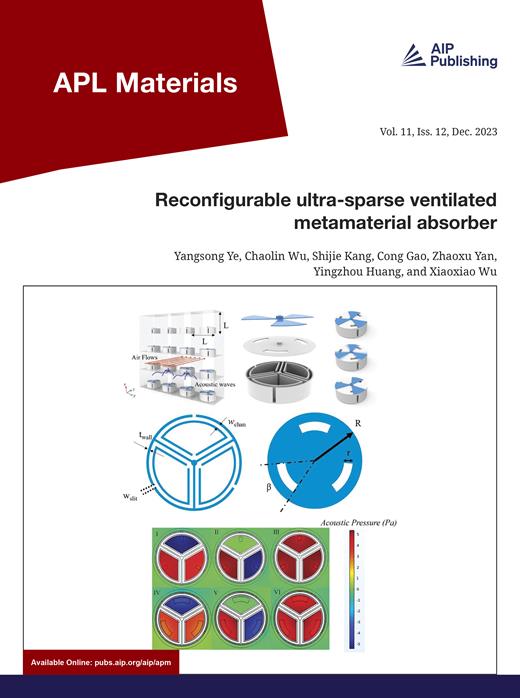Sb surface terminated MnSb devices in the niccolite phase
IF 5.3
2区 材料科学
Q2 MATERIALS SCIENCE, MULTIDISCIPLINARY
引用次数: 0
Abstract
The magneto-electronic properties of ferromagnetic MnSb grown by molecular beam epitaxy can be dominated by the presence of a surface state in the minority spin bandgap when the surface is Sb-terminated. The material resistivity is 120 µΩ.cm at 295 K, and although this is determined by the majority spin population, the anisotropic magnetoresistance, dependent on minority spins, is ∼0.24% for the Sb-terminated devices with Mn-terminated devices showing ∼0.02%. At 295 K, the extraordinary Hall constant is 0.5 Ω/T for the Sb-terminated surface and 1.5 Ω/T for the Mn-terminated surface with the extraordinary Hall constant and anisotropic magnetoresistance behaving with an anomalous temperature dependence between 295 and 1.5 K. The dominant MnSb structural phase on the GaAs (001) orientation is naturally doped p-type with a carrier density ∼1 × 1022 cm−3 determined by the normal Hall effect after the extraordinary Hall effect has saturated at higher fields than ∼2 T. Spintronic device possibilities are discussed, particularly the spin-light emitting diode and magnetic nano-structures. A natural p-type doping in MnSb limits the devices to dominant hole carrier effects although there is compatibility with both III–V and Si–Ge materials for hybrid device possibilities.镍钴石相中的锑表面端接锰钴器件
通过分子束外延生长的铁磁性锰锑的磁电特性,在表面以锑为端时,可能会受到少数自旋带隙中表面态存在的支配。在 295 K 时,材料的电阻率为 120 µΩ.cm,尽管这是由多数自旋群决定的,但取决于少数自旋的各向异性磁阻在 Sb 端器件中为 0.24%,而在 Mn 端器件中为 0.02%。在 295 K 时,Sb 端面的超常霍尔常数为 0.5 Ω/T,而 Mn 端面的超常霍尔常数为 1.5 Ω/T,超常霍尔常数和各向异性磁阻在 295 至 1.5 K 之间表现出反常的温度依赖性。砷化镓(001)取向上的主要 MnSb 结构相是自然掺杂的 p 型,其载流子密度 ∼1 × 1022 cm-3,是在非凡霍尔效应在高于 ∼2 T 的高场饱和后由正常霍尔效应确定的。锰锑中的天然 p 型掺杂限制了器件的主要空穴载流子效应,但它与 III-V 和 Si-Ge 材料兼容,可用于混合器件。
本文章由计算机程序翻译,如有差异,请以英文原文为准。
求助全文
约1分钟内获得全文
求助全文
来源期刊

APL Materials
NANOSCIENCE & NANOTECHNOLOGYMATERIALS SCIE-MATERIALS SCIENCE, MULTIDISCIPLINARY
CiteScore
9.60
自引率
3.30%
发文量
199
审稿时长
2 months
期刊介绍:
APL Materials features original, experimental research on significant topical issues within the field of materials science. In order to highlight research at the forefront of materials science, emphasis is given to the quality and timeliness of the work. The journal considers theory or calculation when the work is particularly timely and relevant to applications.
In addition to regular articles, the journal also publishes Special Topics, which report on cutting-edge areas in materials science, such as Perovskite Solar Cells, 2D Materials, and Beyond Lithium Ion Batteries.
 求助内容:
求助内容: 应助结果提醒方式:
应助结果提醒方式:


